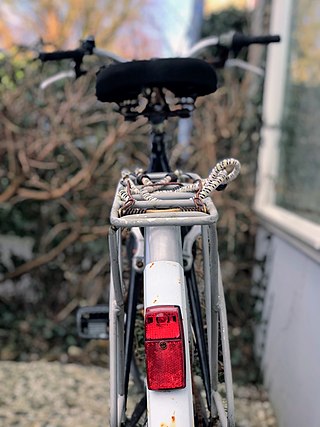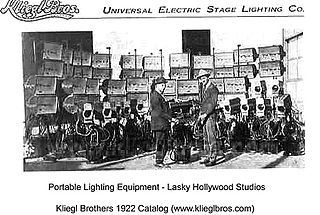The film industry is built upon many technologies and techniques, drawing upon photography, stagecraft, music, and many other disciplines. Following is an index of specific terminology applicable thereto.

Stage lighting is the craft of lighting as it applies to the production of theater, dance, opera, and other performance arts. Several different types of stage lighting instruments are used in this discipline. In addition to basic lighting, modern stage lighting can also include special effects, such as lasers and fog machines. People who work on stage lighting are commonly referred to as lighting technicians or lighting designers.

A flashlight or torch is a portable hand-held electric lamp. Formerly, the light source typically was a miniature incandescent light bulb, but these have been displaced by light-emitting diodes (LEDs) since the mid-2000s. A typical flashlight consists of the light source mounted in a reflector, a transparent cover to protect the light source and reflector, a battery, and a switch, all enclosed in a case.

A headlamp is a lamp attached to the front of a vehicle to illuminate the road ahead. Headlamps are also often called headlights, but in the most precise usage, headlamp is the term for the device itself and headlight is the term for the beam of light produced and distributed by the device.

Bicycle lighting is illumination attached to bicycles whose purpose above all is, along with reflectors, to improve the visibility of the bicycle and its rider to other road users under circumstances of poor ambient illumination. A secondary purpose is to illuminate reflective materials such as cat's eyes and traffic signs. A third purpose may be to illuminate the roadway so that the rider can see the way ahead. Serving the latter purposes require much more luminous flux and thus more power.

A gobo is an object placed inside or in front of a light source to control the shape of the emitted light and its shadow.

Ellipsoidal reflector spot is the name for a type of stage lighting instrument, named for the ellipsoidal reflector used to collect and direct the light through a barrel that contains a lens or lens train. The optics of an ERS instrument are roughly similar to those of a 35 mm slide projector.

In stage lighting, an ellipsoidal reflector floodlight, better known as a scoop, is a large, simple lighting fixture with a dome-like reflector, large high-wattage lamp and no lens. It consists almost entirely of a lamp in the center of a big curved metal dome that acts as a reflector. The result is a wide, soft-edged pool of light good for general lighting. However, since scoop lights do not have a mechanism for cutting down the size of their beam, they are rarely used for more specific lighting needs.

A light fixture, light fitting, or luminaire is an electrical device containing an electric lamp that provides illumination. All light fixtures have a fixture body and one or more lamps. The lamps may be in sockets for easy replacement—or, in the case of some LED fixtures, hard-wired in place.

A parabolic aluminized reflector lamp is a type of electric lamp that is widely used in commercial, residential, and transportation illumination. It produces a highly directional beam. Usage includes theatrical lighting, locomotive headlamps, aircraft landing lights, and residential and commercial recessed lights.

A Fresnel lantern is a common lantern used in theatre that employs a Fresnel lens to wash light over an area of the stage. The lens produces a wider, soft-edged beam of light, which is commonly used for back light and top light.

Stage lighting instruments are used in stage lighting to illuminate theatrical productions, concerts, and other performances taking place in live performance venues. They are also used to light television studios and sound stages.

The Electronic Theatre Controls (ETC) Source Four is an ellipsoidal reflector spotlight (ERS) used in stage lighting. First released in 1992, the Source Four was invented by David Cunningham and features an improved lamp and reflector compared to previous ERS designs, tool-free lamp adjustment, and a rotating, interchangeable shutter barrel. The Source Four is widely used by professional theaters across the globe.

The Source Four PAR is a stage lighting instrument manufactured by Electronic Theatre Controls. The name of the fixture derives from the stylistic and construction features it shares with ETC's Source Four. The suffix identifies the Source Four PAR as a parabolic aluminized reflector (PAR). It is designed and marketed as a modern, energy efficient alternative to traditional PAR fixtures used in theatrical and broadcast lighting.

The SeaChanger Color Engine is an electro-mechanical device that is used to control light color in entertainment-industry lighting applications. The unit employs four overlapped color filter wheels, inserted into a light beam near its source, to produce colored light. This is in contrast to color scrollers, which insert color filter ribbons into a light beam. The color engine, which was released by Ocean Thin Films in 2005, is designed to fit into the Source Four lighting instrument made by Electronic Theatre Controls.

LED stage lighting instruments are stage lighting instruments that use light-emitting diodes (LEDs) as a light source. LED instruments are an alternative to traditional stage lighting instruments which use halogen lamp or high-intensity discharge lamps. Like other LED instruments, they have high light output with lower power consumption.
Articles related to the field of motion pictures include:
Stage lighting accessories are components manufactured for conventional (non-automated) stage lighting instruments. Most conventional fixtures are designed to accept a number of different accessories designed to assist in the modification of the output. These accessories are intended to either provide relatively common functionality not originally provided in a fixture, or to extend the versatility of a lighting instrument by introducing features. Other accessories have been designed to overcome limitations or difficulties some fixtures present in specific applications.

Kliegl Brothers Universal Electric Stage Lighting Company was an American manufacturer of electrical stage lighting products in the 20th century. The company had a significant influence in the development of theatrical, cinema, television, and specialty lighting. It equipped many major performing venues in the United States and its products were used in several other countries as well. Their eponymous product, the Klieglight, was the trade name for two quite different production lights manufactured by the company, and survives today in both industry argot and in popular idiom as a synonym for "spotlight" or "center of attention".

Anton Tiberius Kliegl was a German–American businessman and inventor.

















